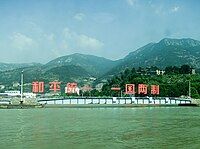Cross-Strait propaganda
Cross-Strait propaganda (simplified Chinese: 台海心战; traditional Chinese: 台海心戰; pinyin: Táihǎi xīn zhàn) refers to campaigns made by the Republic of China on Taiwan and the People's Republic of China on the mainland. Many of these were aimed at turning military personnel against each other's regimes and encouraging them to defect. Such activities began after the end of the Chinese Civil War and did not stop until 1990. However, some creations of this era are still in use today, such as signs facing away from their country of origin. Both sides used megaphones and radio stations for broadcasting, and balloons and floating carriers for sending leaflets and other objects.[1] Defectors came from both sides, bringing with them information and intelligence about their original regimes.
Broadcasting stations
| Mainland China (PRC) | Taiwan (ROC) |
|---|---|
| Voice of the Strait[2] | Voice of Han |
| Fu Hsing Broadcasting Station |
See also
References
- ^ Yang, Min (2 Oct 2011). "台海大喇叭"隔空喊话"38年:无烟战斗中亦有默契" [The Taiwan Strait Loudspeaker "Shouting at the Sky". 38 Years Later, There is Information to be Learned from this Peaceful Conflict]. People's Daily (in Chinese). Archived from the original on 2011-06-08. Retrieved 13 Oct 2019.
- ^ Kania, Elsa (2017-02-15). "The Role of PLA Base 311 in Political Warfare against Taiwan (Part 3)". Global Taiwan Institute. Retrieved 2023-12-09.
- CS1 Chinese-language sources (zh)
- Articles containing simplified Chinese-language text
- Articles containing traditional Chinese-language text
- Pages using navbox columns without the first column
- Cross-Strait relations
- Propaganda in China
- Cold War propaganda
- Propaganda in Taiwan
- All stub articles
- Chinese history stubs

